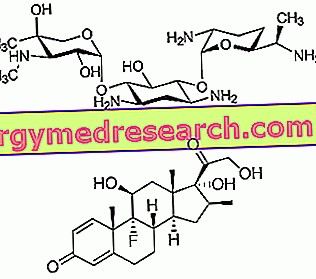Gentamicin is an antibiotic belonging to the aminoglycoside family. It is available in pharmaceutical preparations both alone and in combination with betamethasone (an anti-inflammatory drug of the steroid type used in the treatment of inflammatory and allergic manifestations).

Chemical Structure of Gentamicin (above) and Betamethasone (below)
Gentamicin, in reality, is a mixture of several molecules with an antibiotic action whose major components are gentamicin C-1, gentamicin C-1a and gentamicin C-2.
Betamethasone gentamicin is available as a skin cream.
Indications
For what it uses
The use of gentamicin and betamethasone is indicated in the treatment of inflammatory and allergic skin irritations, such as:
- Eczema of various kinds;
- Anogenital itching;
- Itching in the elderly;
- contact dermatitis;
- Seborrheic dermatitis;
- Neurodermatitis;
- Intertrigo;
- Exfoliative dermatitis;
- Radiation dermatitis;
- Stasis dermatitis;
- Sunburn;
- Psoriasis.
Warnings
If irritation or sensitization occurs during the use of gentamicin and betamethasone, treatment with the drug should be stopped immediately and the doctor should be informed immediately.
The use of betamethasone - even if topically - can cause a decrease in the functionality of the adrenal glands.
The use of gentamicin and betamethasone on large areas of skin, especially if injured, for long periods and with the use of occlusive bandages, can cause an increase in the systemic absorption of gentamicin and betamethasone themselves. In these cases, some of the adverse effects that can occur when gentamicin is administered systemically may arise, therefore, much caution should be used.
Prolonged use of antibiotics - even topically - can favor the development of infections from resistant bacteria and fungi. If this occurs, treatment with gentamicin and betamethasone should be discontinued and specific therapy against these secondary infections should be initiated.
Interactions
There are no known interactions between gentamicin and betamethasone for topical use and other medicines.
However, it is still necessary to inform your doctor if you are taking - or have recently been - medicines of any kind, including non-prescription medicines and herbal and / or homeopathic products.
Side effects
The use of gentamicin and betamethasone can cause the onset of side effects, even if not all patients manifest them. This is due to the different sensitivity that each individual has towards the drug.
The side effects that may occur during therapy with gentamicin and betamethasone affect the skin and subcutaneous tissue. More specifically, the possible adverse effects that may arise during therapy are:
- Temporary skin irritation;
- Skin eruptions;
- rashes;
- Itch;
- Burning and / or dryness of the skin;
- Folliculitis, that is the infection of the hair follicles;
- Hypertrichosis, ie the increase in hair growth;
- Irritations accompanied by pimples;
- Dermatitis affecting the areas around the mouth;
- Allergic contact dermatitis;
- Hypopigmentation, that is a reduced coloring of the skin.
Side effects due to occlusive dressing
The use of the occlusive bandage may cause an increase in side effects, such as:
- Formations of lesions on the skin (skin maceration);
- Development of secondary infections;
- Thinning of the skin (skin atrophy);
- Appearance of stretch marks;
- Appearance of an inflammation of the skin called miliaria.
Additional side effects in children
Children are much more sensitive to possible side effects caused by corticosteroids than adults. Therefore, they are also more sensitive to the possible side effects that may be caused by betamethasone and may lead to:
- Depression of the hypothalamic-pituitary-adrenal axis and decrease of cortisol levels in the bloodstream;
- Increased cortisol production;
- Growth delay;
- Intracranial hypertension that can manifest itself with symptoms such as headache and swelling of the nerves behind the ear.
Action mechanism
Gentamicin and betamethasone are two different active ingredients that perform different activities.
Gentamicin is an antibiotic that exerts its antibacterial action by interfering with the protein synthesis of bacteria.
The synthesis of proteins within the bacterial cells takes place thanks to particular organelles, the ribosomes. These organelles consist of ribosomal RNA and proteins associated with each other to form two subunits: the 30S subunit and the 50S subunit.
The task of the ribosome is to translate the messenger RNA from the cell nucleus and to synthesize the proteins for which it encodes.
Gentamicin binds to the 30S ribosomal subunit, by doing so, it is able to prevent messenger-ribosome RNA binding and, furthermore, hinders the "reading" of the same messenger RNA, leading the ribosome to synthesize "wrong" proteins, called non-proteins. sense.
Some of these non-sense proteins enter the bacterial cell membrane altering their permeability. The alteration of the permeability of the bacterial cell membrane allows the entry of new antibiotic into the same cell, causing a total block of protein synthesis.
These mechanisms have devastating consequences on the bacterial cell which, therefore, undergoes certain death.
Betamethasone, on the other hand, is a steroidal anti-inflammatory and - as such - acts on the inflammatory component.
More precisely, betamethasone decreases the activity of inflammatory cells (such as neutrophils, macrophages, T-helper cells, etc.) and decreases the production of mediators of the inflammatory and immune response (such as prostanoids, cytokines, adhesion factors, etc.) .
Mode of Use - Posology
As mentioned above, gentamicin and betamethasone are available as a skin cream.
The use of the drug must be done strictly according to the doctor's instructions.
The drug should NOT be applied to the eyes.
It is recommended to apply a small amount of gentamicin and betamethasone in the area to be treated at least two or three times a day.
In case of dealing with infected deep dermatoses or psoriasis lesions, the use of the occlusive bandage can be used in order to obtain a better response to the therapy.
Pregnancy and breastfeeding
The use of gentamicin and betamethasone by pregnant women should be carried out only in cases of actual need and only after asking the doctor for advice but, in any case, treatment with the drug in pregnant women should not be done at high doses and for long periods.
Breast-feeding mothers, before taking gentamicin and betamethasone, should seek advice from their doctor who - depending on the condition of each patient - will decide whether to stop breast-feeding or to avoid drug therapy .
Contraindications
The use of gentamicin and betamethasone is contraindicated in the following cases:
- In patients with known hypersensitivity to gentamicin or betamethasone;
- In patients with cutaneous tuberculosis (a particular type of skin infection);
- In patients with skin infections caused by viruses such as Herpes simplex .



